Taxation Law and Practice Assignment: Rod's Tax Liability (BUSL320)
VerifiedAdded on 2022/10/02
|7
|1724
|143
Report
AI Summary
This assignment analyzes the tax implications for Rod in Australia for the tax years 2018/2019 and 2019/2020. The primary focus is on determining Rod's tax residency status, considering factors such as his move to Hong Kong and application of the common law, domicile, and other relevant tests outlined in the Income Tax Assessment Act 1936 (ITAA 1936) and tax rulings like TR98/17. The assessment then determines the assessable income based on his residency status, applying the provisions of ss. 6-5(2) and 6-5(3) ITAA 1997. The assignment concludes that Rod is a foreign tax resident for both years, and therefore, only income from Australian sources would be assessable. Since Rod's income is sourced from Hong Kong, there is no Australian tax liability for either tax year. The analysis references relevant case law and legislation to support the conclusions.
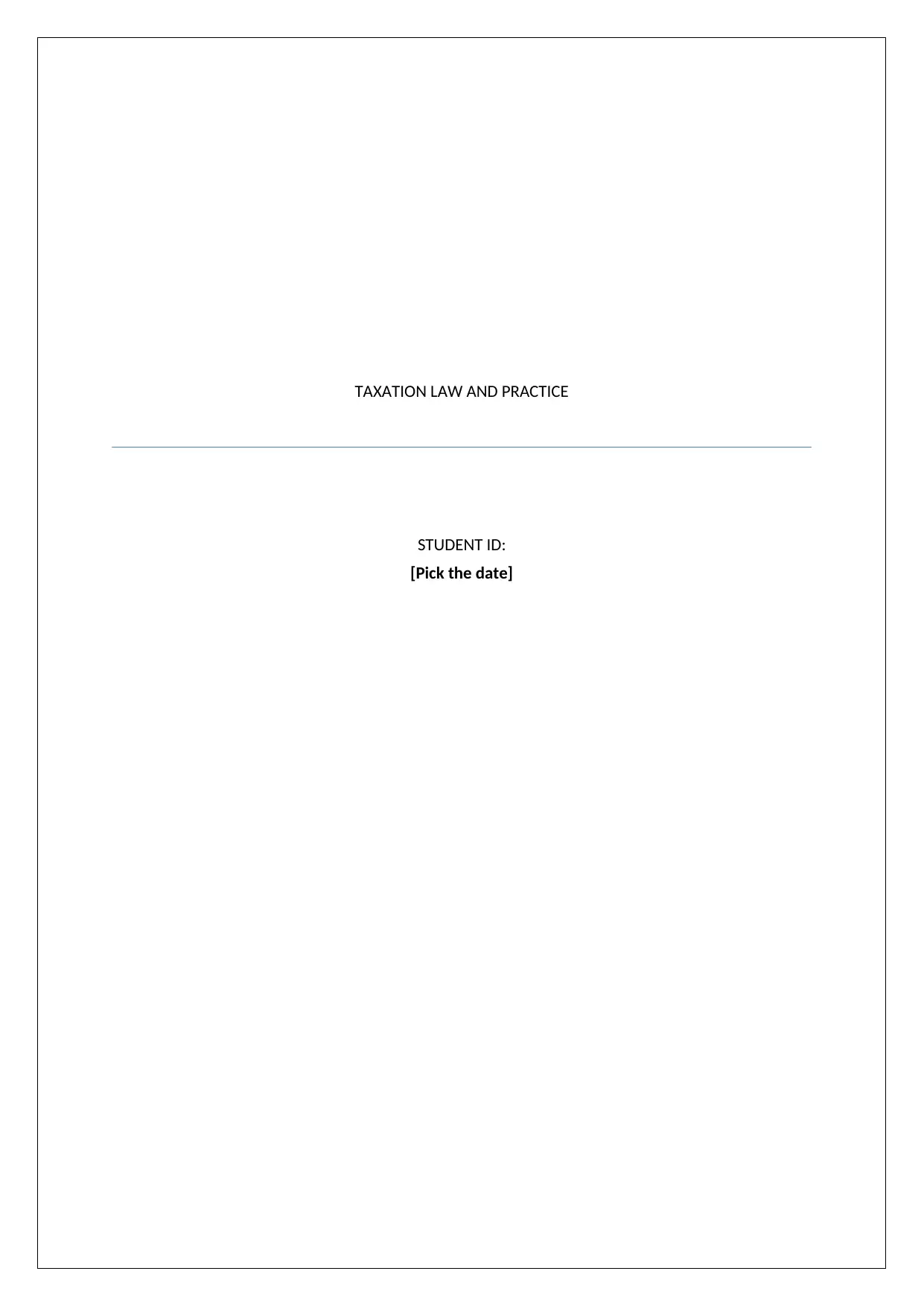
TAXATION LAW AND PRACTICE
STUDENT ID:
[Pick the date]
STUDENT ID:
[Pick the date]
Paraphrase This Document
Need a fresh take? Get an instant paraphrase of this document with our AI Paraphraser
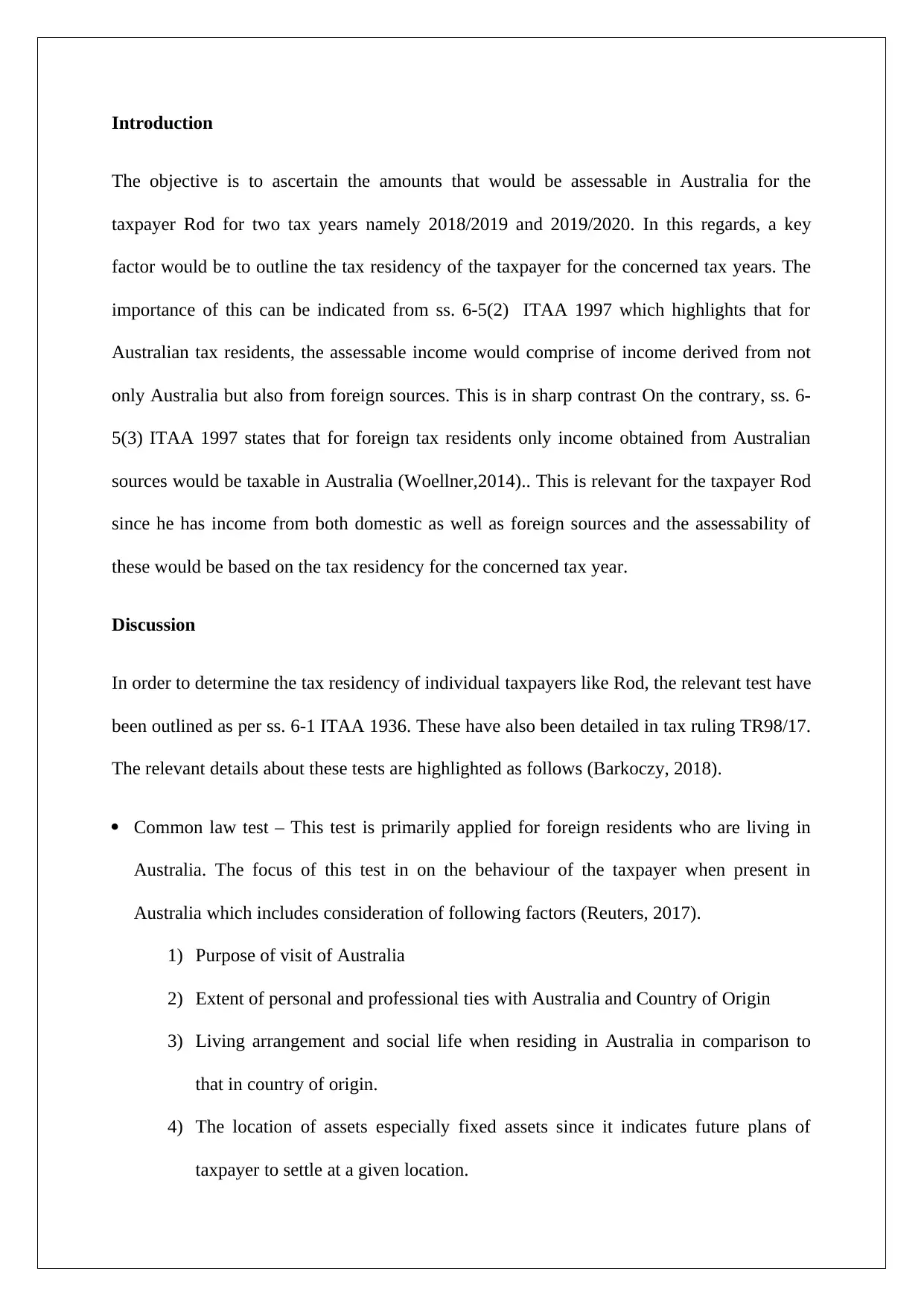
Introduction
The objective is to ascertain the amounts that would be assessable in Australia for the
taxpayer Rod for two tax years namely 2018/2019 and 2019/2020. In this regards, a key
factor would be to outline the tax residency of the taxpayer for the concerned tax years. The
importance of this can be indicated from ss. 6-5(2) ITAA 1997 which highlights that for
Australian tax residents, the assessable income would comprise of income derived from not
only Australia but also from foreign sources. This is in sharp contrast On the contrary, ss. 6-
5(3) ITAA 1997 states that for foreign tax residents only income obtained from Australian
sources would be taxable in Australia (Woellner,2014).. This is relevant for the taxpayer Rod
since he has income from both domestic as well as foreign sources and the assessability of
these would be based on the tax residency for the concerned tax year.
Discussion
In order to determine the tax residency of individual taxpayers like Rod, the relevant test have
been outlined as per ss. 6-1 ITAA 1936. These have also been detailed in tax ruling TR98/17.
The relevant details about these tests are highlighted as follows (Barkoczy, 2018).
Common law test – This test is primarily applied for foreign residents who are living in
Australia. The focus of this test in on the behaviour of the taxpayer when present in
Australia which includes consideration of following factors (Reuters, 2017).
1) Purpose of visit of Australia
2) Extent of personal and professional ties with Australia and Country of Origin
3) Living arrangement and social life when residing in Australia in comparison to
that in country of origin.
4) The location of assets especially fixed assets since it indicates future plans of
taxpayer to settle at a given location.
The objective is to ascertain the amounts that would be assessable in Australia for the
taxpayer Rod for two tax years namely 2018/2019 and 2019/2020. In this regards, a key
factor would be to outline the tax residency of the taxpayer for the concerned tax years. The
importance of this can be indicated from ss. 6-5(2) ITAA 1997 which highlights that for
Australian tax residents, the assessable income would comprise of income derived from not
only Australia but also from foreign sources. This is in sharp contrast On the contrary, ss. 6-
5(3) ITAA 1997 states that for foreign tax residents only income obtained from Australian
sources would be taxable in Australia (Woellner,2014).. This is relevant for the taxpayer Rod
since he has income from both domestic as well as foreign sources and the assessability of
these would be based on the tax residency for the concerned tax year.
Discussion
In order to determine the tax residency of individual taxpayers like Rod, the relevant test have
been outlined as per ss. 6-1 ITAA 1936. These have also been detailed in tax ruling TR98/17.
The relevant details about these tests are highlighted as follows (Barkoczy, 2018).
Common law test – This test is primarily applied for foreign residents who are living in
Australia. The focus of this test in on the behaviour of the taxpayer when present in
Australia which includes consideration of following factors (Reuters, 2017).
1) Purpose of visit of Australia
2) Extent of personal and professional ties with Australia and Country of Origin
3) Living arrangement and social life when residing in Australia in comparison to
that in country of origin.
4) The location of assets especially fixed assets since it indicates future plans of
taxpayer to settle at a given location.
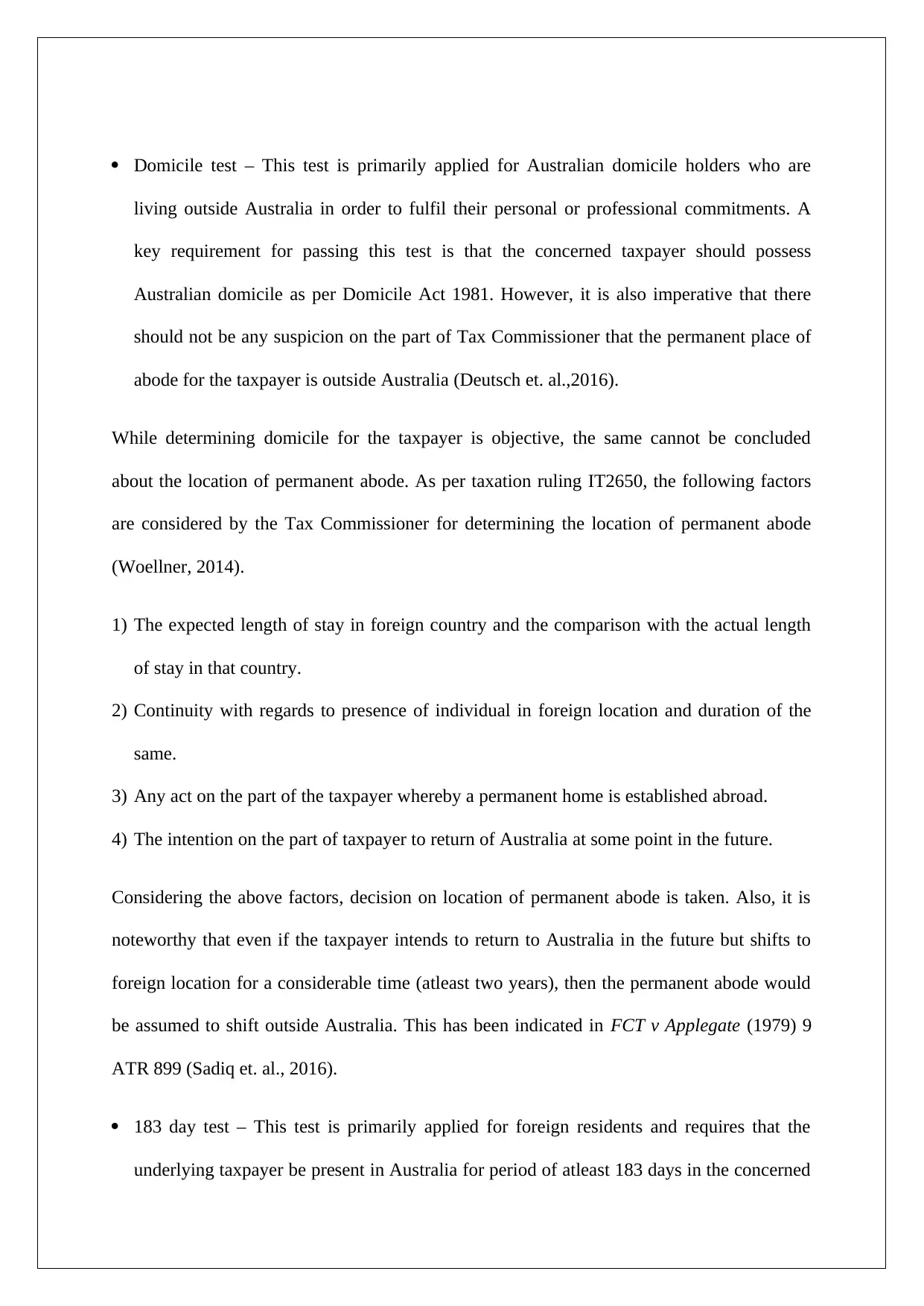
Domicile test – This test is primarily applied for Australian domicile holders who are
living outside Australia in order to fulfil their personal or professional commitments. A
key requirement for passing this test is that the concerned taxpayer should possess
Australian domicile as per Domicile Act 1981. However, it is also imperative that there
should not be any suspicion on the part of Tax Commissioner that the permanent place of
abode for the taxpayer is outside Australia (Deutsch et. al.,2016).
While determining domicile for the taxpayer is objective, the same cannot be concluded
about the location of permanent abode. As per taxation ruling IT2650, the following factors
are considered by the Tax Commissioner for determining the location of permanent abode
(Woellner, 2014).
1) The expected length of stay in foreign country and the comparison with the actual length
of stay in that country.
2) Continuity with regards to presence of individual in foreign location and duration of the
same.
3) Any act on the part of the taxpayer whereby a permanent home is established abroad.
4) The intention on the part of taxpayer to return of Australia at some point in the future.
Considering the above factors, decision on location of permanent abode is taken. Also, it is
noteworthy that even if the taxpayer intends to return to Australia in the future but shifts to
foreign location for a considerable time (atleast two years), then the permanent abode would
be assumed to shift outside Australia. This has been indicated in FCT v Applegate (1979) 9
ATR 899 (Sadiq et. al., 2016).
183 day test – This test is primarily applied for foreign residents and requires that the
underlying taxpayer be present in Australia for period of atleast 183 days in the concerned
living outside Australia in order to fulfil their personal or professional commitments. A
key requirement for passing this test is that the concerned taxpayer should possess
Australian domicile as per Domicile Act 1981. However, it is also imperative that there
should not be any suspicion on the part of Tax Commissioner that the permanent place of
abode for the taxpayer is outside Australia (Deutsch et. al.,2016).
While determining domicile for the taxpayer is objective, the same cannot be concluded
about the location of permanent abode. As per taxation ruling IT2650, the following factors
are considered by the Tax Commissioner for determining the location of permanent abode
(Woellner, 2014).
1) The expected length of stay in foreign country and the comparison with the actual length
of stay in that country.
2) Continuity with regards to presence of individual in foreign location and duration of the
same.
3) Any act on the part of the taxpayer whereby a permanent home is established abroad.
4) The intention on the part of taxpayer to return of Australia at some point in the future.
Considering the above factors, decision on location of permanent abode is taken. Also, it is
noteworthy that even if the taxpayer intends to return to Australia in the future but shifts to
foreign location for a considerable time (atleast two years), then the permanent abode would
be assumed to shift outside Australia. This has been indicated in FCT v Applegate (1979) 9
ATR 899 (Sadiq et. al., 2016).
183 day test – This test is primarily applied for foreign residents and requires that the
underlying taxpayer be present in Australia for period of atleast 183 days in the concerned
⊘ This is a preview!⊘
Do you want full access?
Subscribe today to unlock all pages.

Trusted by 1+ million students worldwide
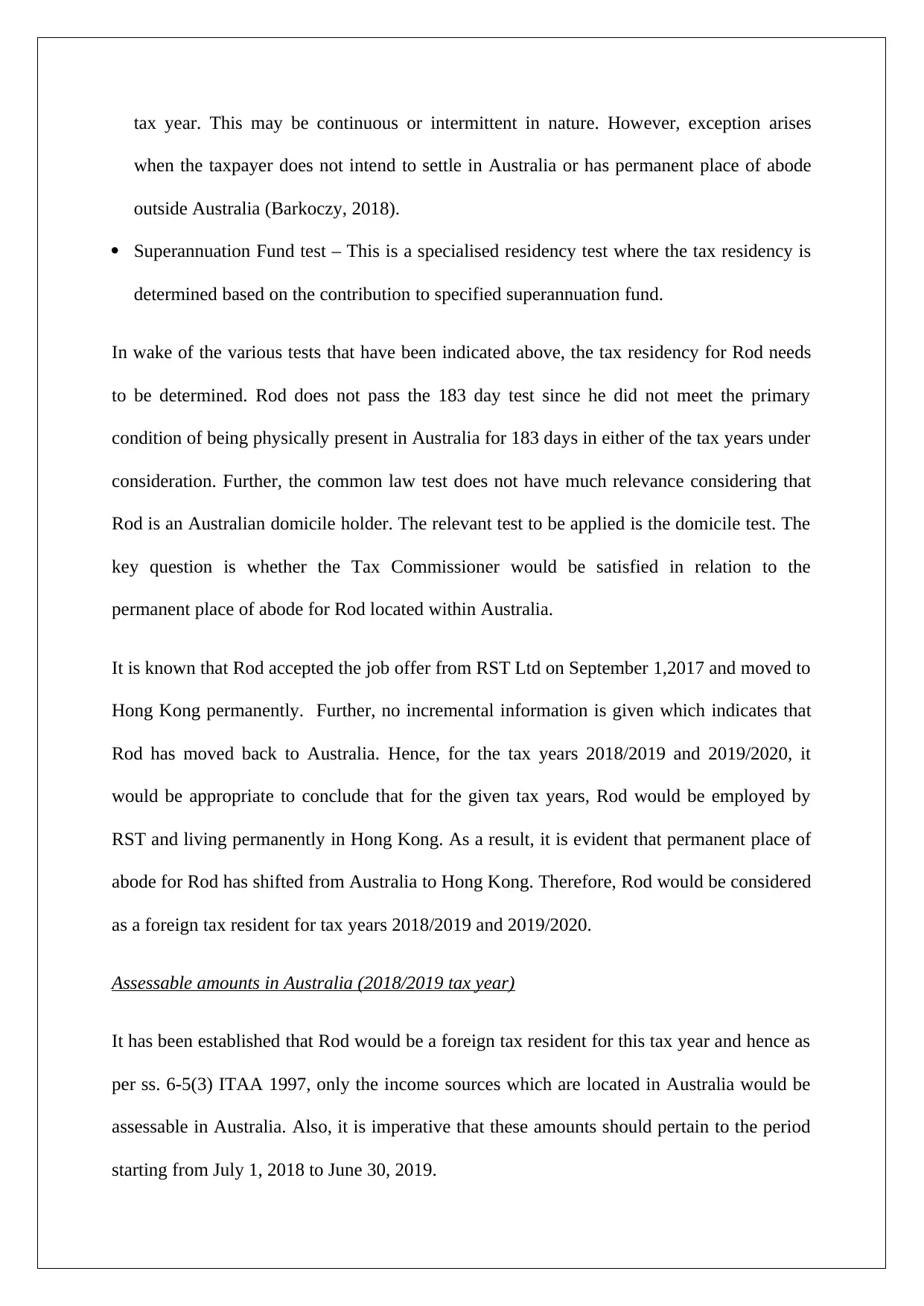
tax year. This may be continuous or intermittent in nature. However, exception arises
when the taxpayer does not intend to settle in Australia or has permanent place of abode
outside Australia (Barkoczy, 2018).
Superannuation Fund test – This is a specialised residency test where the tax residency is
determined based on the contribution to specified superannuation fund.
In wake of the various tests that have been indicated above, the tax residency for Rod needs
to be determined. Rod does not pass the 183 day test since he did not meet the primary
condition of being physically present in Australia for 183 days in either of the tax years under
consideration. Further, the common law test does not have much relevance considering that
Rod is an Australian domicile holder. The relevant test to be applied is the domicile test. The
key question is whether the Tax Commissioner would be satisfied in relation to the
permanent place of abode for Rod located within Australia.
It is known that Rod accepted the job offer from RST Ltd on September 1,2017 and moved to
Hong Kong permanently. Further, no incremental information is given which indicates that
Rod has moved back to Australia. Hence, for the tax years 2018/2019 and 2019/2020, it
would be appropriate to conclude that for the given tax years, Rod would be employed by
RST and living permanently in Hong Kong. As a result, it is evident that permanent place of
abode for Rod has shifted from Australia to Hong Kong. Therefore, Rod would be considered
as a foreign tax resident for tax years 2018/2019 and 2019/2020.
Assessable amounts in Australia (2018/2019 tax year)
It has been established that Rod would be a foreign tax resident for this tax year and hence as
per ss. 6-5(3) ITAA 1997, only the income sources which are located in Australia would be
assessable in Australia. Also, it is imperative that these amounts should pertain to the period
starting from July 1, 2018 to June 30, 2019.
when the taxpayer does not intend to settle in Australia or has permanent place of abode
outside Australia (Barkoczy, 2018).
Superannuation Fund test – This is a specialised residency test where the tax residency is
determined based on the contribution to specified superannuation fund.
In wake of the various tests that have been indicated above, the tax residency for Rod needs
to be determined. Rod does not pass the 183 day test since he did not meet the primary
condition of being physically present in Australia for 183 days in either of the tax years under
consideration. Further, the common law test does not have much relevance considering that
Rod is an Australian domicile holder. The relevant test to be applied is the domicile test. The
key question is whether the Tax Commissioner would be satisfied in relation to the
permanent place of abode for Rod located within Australia.
It is known that Rod accepted the job offer from RST Ltd on September 1,2017 and moved to
Hong Kong permanently. Further, no incremental information is given which indicates that
Rod has moved back to Australia. Hence, for the tax years 2018/2019 and 2019/2020, it
would be appropriate to conclude that for the given tax years, Rod would be employed by
RST and living permanently in Hong Kong. As a result, it is evident that permanent place of
abode for Rod has shifted from Australia to Hong Kong. Therefore, Rod would be considered
as a foreign tax resident for tax years 2018/2019 and 2019/2020.
Assessable amounts in Australia (2018/2019 tax year)
It has been established that Rod would be a foreign tax resident for this tax year and hence as
per ss. 6-5(3) ITAA 1997, only the income sources which are located in Australia would be
assessable in Australia. Also, it is imperative that these amounts should pertain to the period
starting from July 1, 2018 to June 30, 2019.
Paraphrase This Document
Need a fresh take? Get an instant paraphrase of this document with our AI Paraphraser
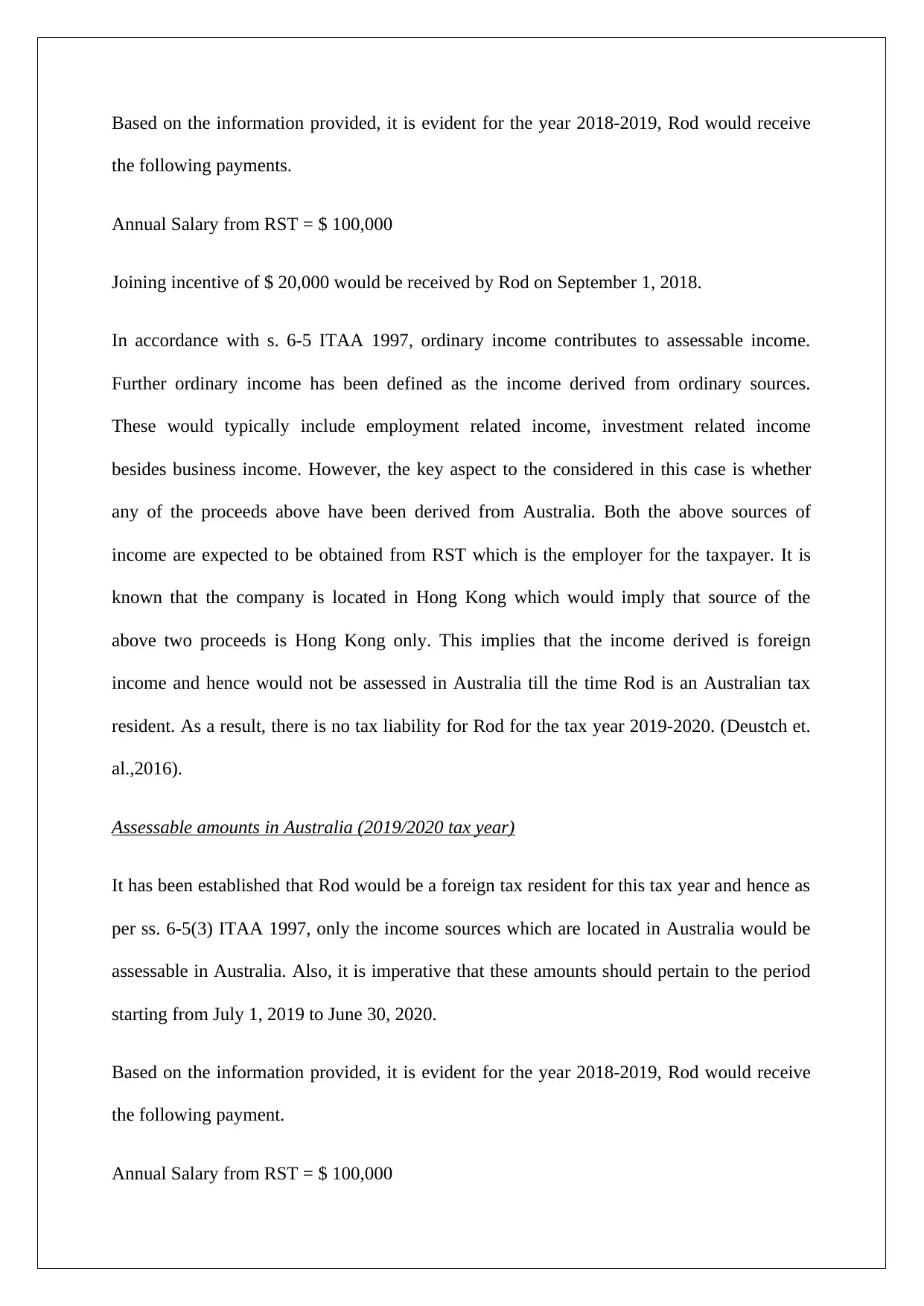
Based on the information provided, it is evident for the year 2018-2019, Rod would receive
the following payments.
Annual Salary from RST = $ 100,000
Joining incentive of $ 20,000 would be received by Rod on September 1, 2018.
In accordance with s. 6-5 ITAA 1997, ordinary income contributes to assessable income.
Further ordinary income has been defined as the income derived from ordinary sources.
These would typically include employment related income, investment related income
besides business income. However, the key aspect to the considered in this case is whether
any of the proceeds above have been derived from Australia. Both the above sources of
income are expected to be obtained from RST which is the employer for the taxpayer. It is
known that the company is located in Hong Kong which would imply that source of the
above two proceeds is Hong Kong only. This implies that the income derived is foreign
income and hence would not be assessed in Australia till the time Rod is an Australian tax
resident. As a result, there is no tax liability for Rod for the tax year 2019-2020. (Deustch et.
al.,2016).
Assessable amounts in Australia (2019/2020 tax year)
It has been established that Rod would be a foreign tax resident for this tax year and hence as
per ss. 6-5(3) ITAA 1997, only the income sources which are located in Australia would be
assessable in Australia. Also, it is imperative that these amounts should pertain to the period
starting from July 1, 2019 to June 30, 2020.
Based on the information provided, it is evident for the year 2018-2019, Rod would receive
the following payment.
Annual Salary from RST = $ 100,000
the following payments.
Annual Salary from RST = $ 100,000
Joining incentive of $ 20,000 would be received by Rod on September 1, 2018.
In accordance with s. 6-5 ITAA 1997, ordinary income contributes to assessable income.
Further ordinary income has been defined as the income derived from ordinary sources.
These would typically include employment related income, investment related income
besides business income. However, the key aspect to the considered in this case is whether
any of the proceeds above have been derived from Australia. Both the above sources of
income are expected to be obtained from RST which is the employer for the taxpayer. It is
known that the company is located in Hong Kong which would imply that source of the
above two proceeds is Hong Kong only. This implies that the income derived is foreign
income and hence would not be assessed in Australia till the time Rod is an Australian tax
resident. As a result, there is no tax liability for Rod for the tax year 2019-2020. (Deustch et.
al.,2016).
Assessable amounts in Australia (2019/2020 tax year)
It has been established that Rod would be a foreign tax resident for this tax year and hence as
per ss. 6-5(3) ITAA 1997, only the income sources which are located in Australia would be
assessable in Australia. Also, it is imperative that these amounts should pertain to the period
starting from July 1, 2019 to June 30, 2020.
Based on the information provided, it is evident for the year 2018-2019, Rod would receive
the following payment.
Annual Salary from RST = $ 100,000
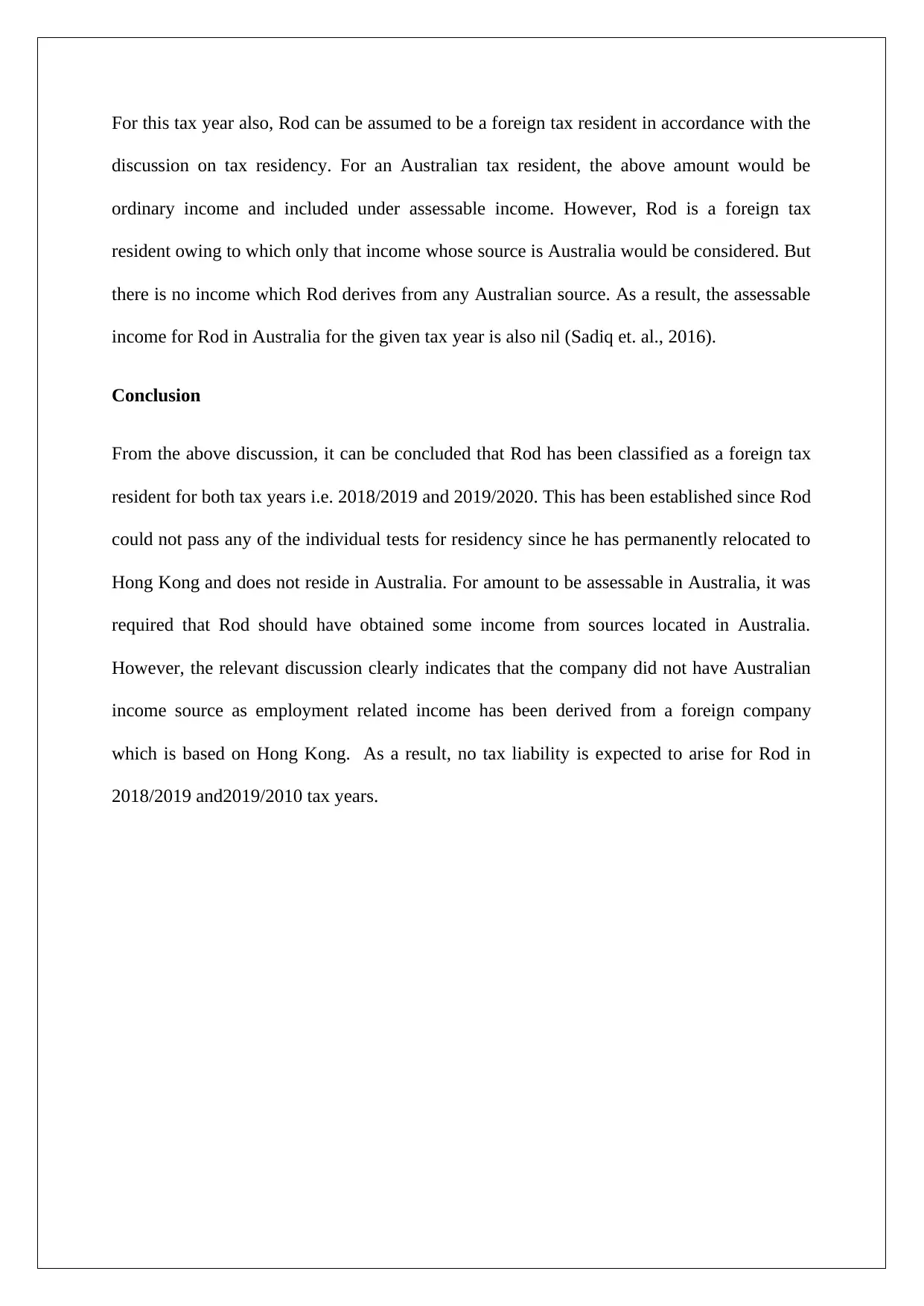
For this tax year also, Rod can be assumed to be a foreign tax resident in accordance with the
discussion on tax residency. For an Australian tax resident, the above amount would be
ordinary income and included under assessable income. However, Rod is a foreign tax
resident owing to which only that income whose source is Australia would be considered. But
there is no income which Rod derives from any Australian source. As a result, the assessable
income for Rod in Australia for the given tax year is also nil (Sadiq et. al., 2016).
Conclusion
From the above discussion, it can be concluded that Rod has been classified as a foreign tax
resident for both tax years i.e. 2018/2019 and 2019/2020. This has been established since Rod
could not pass any of the individual tests for residency since he has permanently relocated to
Hong Kong and does not reside in Australia. For amount to be assessable in Australia, it was
required that Rod should have obtained some income from sources located in Australia.
However, the relevant discussion clearly indicates that the company did not have Australian
income source as employment related income has been derived from a foreign company
which is based on Hong Kong. As a result, no tax liability is expected to arise for Rod in
2018/2019 and2019/2010 tax years.
discussion on tax residency. For an Australian tax resident, the above amount would be
ordinary income and included under assessable income. However, Rod is a foreign tax
resident owing to which only that income whose source is Australia would be considered. But
there is no income which Rod derives from any Australian source. As a result, the assessable
income for Rod in Australia for the given tax year is also nil (Sadiq et. al., 2016).
Conclusion
From the above discussion, it can be concluded that Rod has been classified as a foreign tax
resident for both tax years i.e. 2018/2019 and 2019/2020. This has been established since Rod
could not pass any of the individual tests for residency since he has permanently relocated to
Hong Kong and does not reside in Australia. For amount to be assessable in Australia, it was
required that Rod should have obtained some income from sources located in Australia.
However, the relevant discussion clearly indicates that the company did not have Australian
income source as employment related income has been derived from a foreign company
which is based on Hong Kong. As a result, no tax liability is expected to arise for Rod in
2018/2019 and2019/2010 tax years.
⊘ This is a preview!⊘
Do you want full access?
Subscribe today to unlock all pages.

Trusted by 1+ million students worldwide
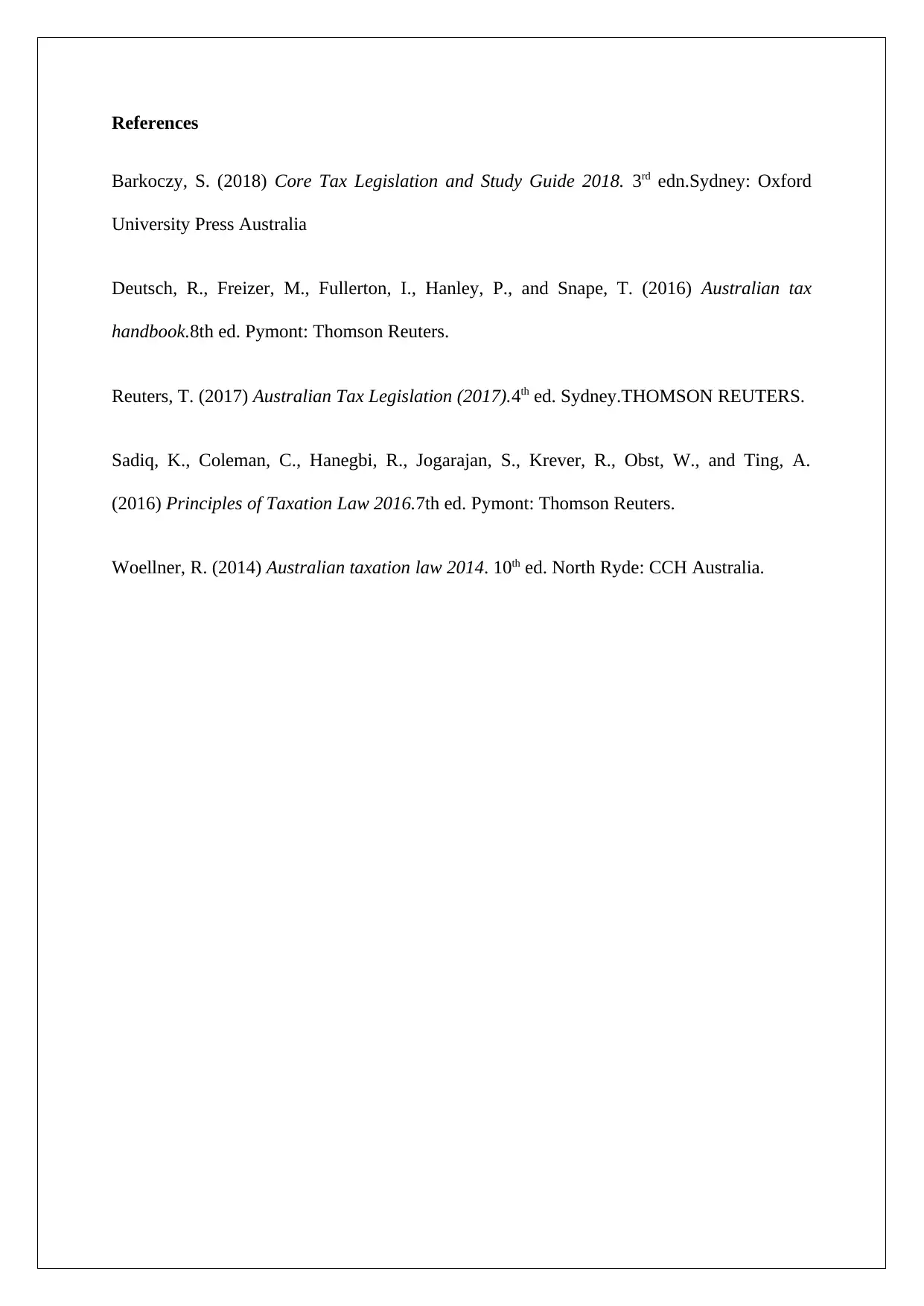
References
Barkoczy, S. (2018) Core Tax Legislation and Study Guide 2018. 3rd edn.Sydney: Oxford
University Press Australia
Deutsch, R., Freizer, M., Fullerton, I., Hanley, P., and Snape, T. (2016) Australian tax
handbook.8th ed. Pymont: Thomson Reuters.
Reuters, T. (2017) Australian Tax Legislation (2017).4th ed. Sydney.THOMSON REUTERS.
Sadiq, K., Coleman, C., Hanegbi, R., Jogarajan, S., Krever, R., Obst, W., and Ting, A.
(2016) Principles of Taxation Law 2016.7th ed. Pymont: Thomson Reuters.
Woellner, R. (2014) Australian taxation law 2014. 10th ed. North Ryde: CCH Australia.
Barkoczy, S. (2018) Core Tax Legislation and Study Guide 2018. 3rd edn.Sydney: Oxford
University Press Australia
Deutsch, R., Freizer, M., Fullerton, I., Hanley, P., and Snape, T. (2016) Australian tax
handbook.8th ed. Pymont: Thomson Reuters.
Reuters, T. (2017) Australian Tax Legislation (2017).4th ed. Sydney.THOMSON REUTERS.
Sadiq, K., Coleman, C., Hanegbi, R., Jogarajan, S., Krever, R., Obst, W., and Ting, A.
(2016) Principles of Taxation Law 2016.7th ed. Pymont: Thomson Reuters.
Woellner, R. (2014) Australian taxation law 2014. 10th ed. North Ryde: CCH Australia.
1 out of 7
Related Documents
Your All-in-One AI-Powered Toolkit for Academic Success.
+13062052269
info@desklib.com
Available 24*7 on WhatsApp / Email
![[object Object]](/_next/static/media/star-bottom.7253800d.svg)
Unlock your academic potential
Copyright © 2020–2025 A2Z Services. All Rights Reserved. Developed and managed by ZUCOL.





